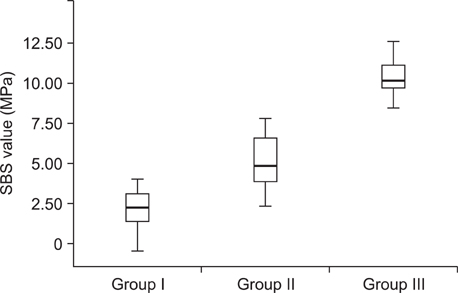Korean J Orthod.
2013 Apr;43(2):96-100. 10.4041/kjod.2013.43.2.96.
Effects of contamination by either blood or a hemostatic agent on the shear bond strength of orthodontic buttons
- Affiliations
-
- 1Department of Orthodontics, Faculty of Dentistry, Akdeniz University, Antalya, Turkey. aygungor@gmail.com
- 2Department of Orthodontics, Faculty of Dentistry, Suleyman Demirel University, Isparta, Turkey.
- KMID: 1975149
- DOI: http://doi.org/10.4041/kjod.2013.43.2.96
Abstract
OBJECTIVE
To evaluate the effects of contamination by either blood or a hemostatic agent on the shear bond strength (SBS) of orthodontic buttons.
METHODS
We used 45 freshly extracted, non-carious, impacted third molars that were divided into 3 groups of 15. Each tooth was etched with 37% phosphoric acid gel for 30 s. Human blood or the blood stopper agent was applied to the tooth surface in groups I and II, respectively. Group III teeth were untreated (controls). Orthodontic buttons were bonded to the teeth using light-curing composite resin. After bonding, the SBS of the button was determined using a Universal testing machine. Any adhesive remaining after debonding was assessed and scored according to the modified adhesive remnant index (ARI). ANOVA with post-hoc Tukey's test was used to determine significant differences in SBS and Fisher's exact test, to determine significant differences in ARI scores among groups.
RESULTS
ANOVA indicated a significant difference between groups (p < 0.001). The highest SBS values were measured in group III (10.73 +/- 0.96 MPa). The SBS values for teeth in groups I and II were significantly lower than that of group III (p < 0.001). The lowest SBS values were observed in group I teeth (4.17 +/- 1.11 MPa) (p < 0.001).
CONCLUSIONS
Contamination of tooth surfaces with either blood or hemostatic agent significantly decreased the SBS of orthodontic buttons. When the contamination risk is high, it is recommended to use the blood stopper agent when bonding orthodontic buttons on impacted teeth.
Keyword
MeSH Terms
Figure
Reference
-
1. Shapira Y, Kuftinec MM. Early diagnosis and interception of potential maxillary canine impaction. J Am Dent Assoc. 1998. 129:1450–1454.
Article2. Oonsombat C, Bishara SE, Ajlouni R. The effect of blood contamination on the shear bond strength of orthodontic brackets with the use of a new self-etch primer. Am J Orthod Dentofacial Orthop. 2003. 123:547–550.
Article3. van Schalkwyk JH, Botha FS, van der Vyver PJ, de Wet FA, Botha SJ. Effect of biological contamination on dentine bond strength of adhesive resins. SADJ. 2003. 58:143–147.4. Trakyali G, Oztoprak MO. Plant extract ankaferd blood stopper effect on bond strength. Angle Orthod. 2010. 80:570–574.
Article5. Olsen ME, Bishara SE, Damon P, Jakobsen JR. Evaluation of Scotchbond Multipurpose and maleic acid as alternative methods of bonding orthodontic brackets. Am J Orthod Dentofacial Orthop. 1997. 111:498–501.
Article6. Sayinsu K, Isik F, Sezen S, Aydemir B. Effect of blood and saliva contamination on bond strength of brackets bonded with a protective liquid polish and a light-cured adhesive. Am J Orthod Dentofacial Orthop. 2007. 131:391–394.
Article7. Oztoprak MO, Isik F, Sayinsu K, Arun T, Aydemir B. Effect of blood and saliva contamination on shear bond strength of brackets bonded with 4 adhesives. Am J Orthod Dentofacial Orthop. 2007. 131:238–242.
Article8. Oztürk B, Malkoç S, Koyutürk AE, Catalbas B, Ozer F. Influence of different tooth types on the bond strength of two orthodontic adhesive systems. Eur J Orthod. 2008. 30:407–412.
Article9. Ostby AW, Bishara SE, Denehy GE, Laffoon JF, Warren JJ. Effect of self-etchant pH on the shear bond strength of orthodontic brackets. Am J Orthod Dentofacial Orthop. 2008. 134:203–208.
Article10. Bishara SE, Otsby AW, Ajlouni R, Laffoon J, Warren JJ. A new premixed self-etch adhesive for bonding orthodontic brackets. Angle Orthod. 2008. 78:1101–1104.
Article11. Izadi MI, Sherriff M, Cobourne MT. A comparative investigation into relative bond strengths of Damon3, Damon3MX, and APC II brackets using different primer and adhesive combinations. Eur J Orthod. 2012. 34:778–782.
Article12. Adanir N, Türkkahraman H, Yalçin Güngör A. Effects of adhesion promoters on the shear bond strengths of orthodontic brackets to fluorosed enamel. Eur J Orthod. 2009. 31:276–280.
Article13. Reynolds IR. A review of direct orthodontic bonding. Br J Orthod. 1975. 2:171–178.
Article
- Full Text Links
- Actions
-
Cited
- CITED
-
- Close
- Share
- Similar articles
-
- Effects of Saliva Contamination on Shear Bond Strength with Conventional, Moisture Insensitive, and Self-Etching Primers
- Difference in Bonding Strength of RMGIC according to Type of Hemostatic Agent in Primary Tooth
- Investigation of the Shear Bond Strength of Orthodontic Buttons by Light Curing Using an Extended Optic Fiber
- The shear bond strength of two adhesives bonded to composite resin and glass ionomer cement restorations
- The influence of hemostatic agent contamination on bond strengths on dentin bonding agents


